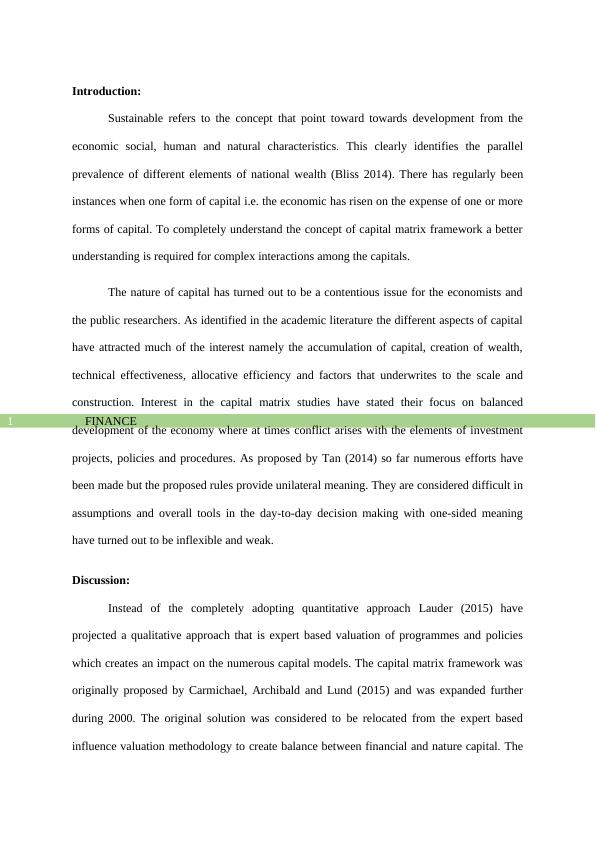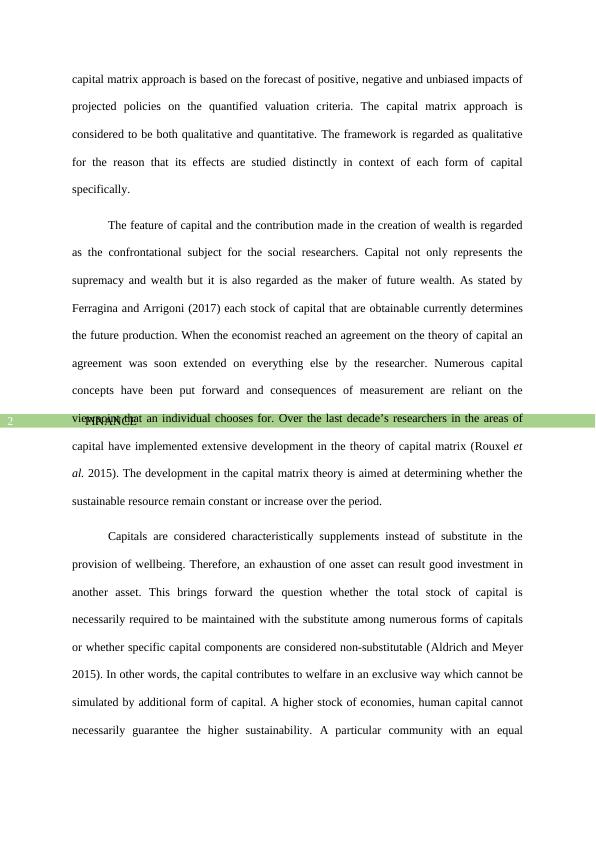Economic, social, and environmental sustainability
9 Pages2039 Words125 Views
Added on 2021-04-24
Economic, social, and environmental sustainability
Added on 2021-04-24
ShareRelated Documents
Running head: FINANCEFinanceName of the StudentName of the UniversityAuthors NoteCourse ID

FINANCE1Introduction: Sustainable refers to the concept that point toward towards development from theeconomic social, human and natural characteristics. This clearly identifies the parallelprevalence of different elements of national wealth (Bliss 2014). There has regularly beeninstances when one form of capital i.e. the economic has risen on the expense of one or moreforms of capital. To completely understand the concept of capital matrix framework a betterunderstanding is required for complex interactions among the capitals. The nature of capital has turned out to be a contentious issue for the economists andthe public researchers. As identified in the academic literature the different aspects of capitalhave attracted much of the interest namely the accumulation of capital, creation of wealth,technical effectiveness, allocative efficiency and factors that underwrites to the scale andconstruction. Interest in the capital matrix studies have stated their focus on balanceddevelopment of the economy where at times conflict arises with the elements of investmentprojects, policies and procedures. As proposed by Tan (2014) so far numerous efforts havebeen made but the proposed rules provide unilateral meaning. They are considered difficult inassumptions and overall tools in the day-to-day decision making with one-sided meaninghave turned out to be inflexible and weak. Discussion:Instead of the completely adopting quantitative approach Lauder (2015) haveprojected a qualitative approach that is expert based valuation of programmes and policieswhich creates an impact on the numerous capital models. The capital matrix framework wasoriginally proposed by Carmichael, Archibald and Lund (2015) and was expanded furtherduring 2000. The original solution was considered to be relocated from the expert basedinfluence valuation methodology to create balance between financial and nature capital. The

FINANCE2capital matrix approach is based on the forecast of positive, negative and unbiased impacts ofprojected policies on the quantified valuation criteria. The capital matrix approach isconsidered to be both qualitative and quantitative. The framework is regarded as qualitativefor the reason that its effects are studied distinctly in context of each form of capitalspecifically. The feature of capital and the contribution made in the creation of wealth is regardedas the confrontational subject for the social researchers. Capital not only represents thesupremacy and wealth but it is also regarded as the maker of future wealth. As stated byFerragina and Arrigoni (2017) each stock of capital that are obtainable currently determinesthe future production. When the economist reached an agreement on the theory of capital anagreement was soon extended on everything else by the researcher. Numerous capitalconcepts have been put forward and consequences of measurement are reliant on theviewpoint that an individual chooses for. Over the last decade’s researchers in the areas ofcapital have implemented extensive development in the theory of capital matrix (Rouxel etal. 2015). The development in the capital matrix theory is aimed at determining whether thesustainable resource remain constant or increase over the period. Capitals are considered characteristically supplements instead of substitute in theprovision of wellbeing. Therefore, an exhaustion of one asset can result good investment inanother asset. This brings forward the question whether the total stock of capital isnecessarily required to be maintained with the substitute among numerous forms of capitalsor whether specific capital components are considered non-substitutable (Aldrich and Meyer2015). In other words, the capital contributes to welfare in an exclusive way which cannot besimulated by additional form of capital. A higher stock of economies, human capital cannotnecessarily guarantee the higher sustainability. A particular community with an equal

End of preview
Want to access all the pages? Upload your documents or become a member.
Related Documents
Contemporary Issues in Accountinglg...
|13
|2200
|29
Significance of Training and Development on Employee Performance at Hiltonlg...
|17
|5680
|450
Are The Leaders Born or Made?lg...
|8
|1371
|293
Importance of KBD for Sustainable Success in a Digitized Worldlg...
|11
|3050
|85
Impact of National Culture on Financial Performance of Pharmaceutical Sector in UKlg...
|1
|1277
|39
Managing Small and Medium Sized Enterprises Assignmentlg...
|22
|6821
|296
